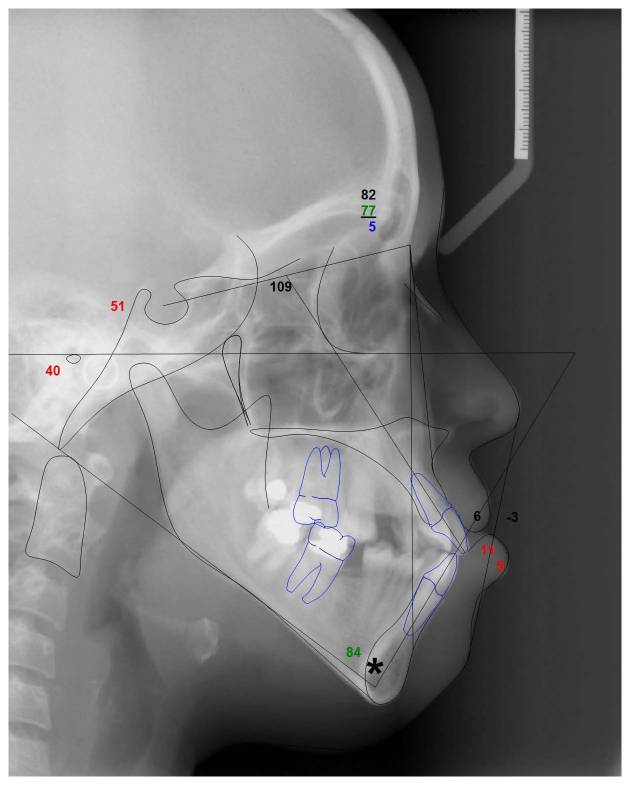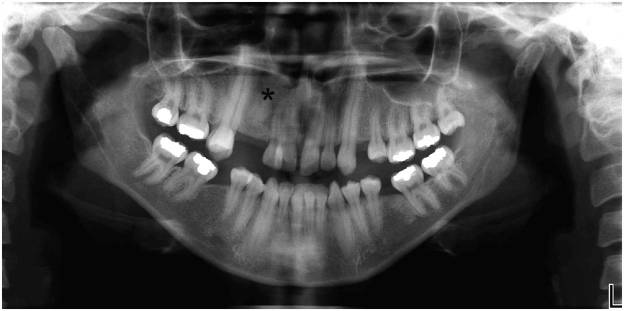Oculofaciocardiodental syndrome: Difference between revisions
No edit summary |
|||
| Line 24: | Line 24: | ||
Oculofaciocardiodental syndrome (OFCD) is a rare congenital condition affecting eyes, heart, face and teeth. This syndrome is a [[X-linked]] syndrome and it has been seen in [[heterygous]] female only. Due to its lethal affects on male, there has been no report of affected male. Common signs ad symptoms include [[cataract]], small deep-set eyes, long narrow face, heart defects and teeth with large roots. | Oculofaciocardiodental syndrome (OFCD) is a rare congenital condition affecting eyes, heart, face and teeth. This syndrome is a [[X-linked]] syndrome and it has been seen in [[heterygous]] female only. Due to its lethal affects on male, there has been no report of affected male. Common signs ad symptoms include [[cataract]], small deep-set eyes, long narrow face, heart defects and teeth with large roots. | ||
==Historical Perspective== | ==Historical Perspective== | ||
Oculofaciocardiodental syndrome is very rare; the incidence is estimated to be less than per million people. OFCD initially was described by Hayward, an oral surgen, in 1980 as ocular, facial, cardiac and dental abnormalities. In 1999, Schulze BR discovered that this syndrome has lethal affects on effected males and it has been seen in only heterozygous females. Further investigations by Hayward and Schulze indicated that OFCD has ocular problems like congenital [[cataract]], [[microphthalmia]] as well as cardiac symptoms like [[atrial septal defect]], [[ventricular septal defect]] and [[mitral valve prolapse]]. Its dental characteristics including delayed tooth eruption and prolonged retention of primary teeth were described in 1990 by Marashi and Gorlin.<ref name="pmid21740180">{{cite journal| author=Davoody A, Chen IP, Nanda R, Uribe F, Reichenberger EJ| title=Oculofaciocardiodental syndrome: a rare case and review of the literature. | journal=Cleft Palate Craniofac J | year= 2012 | volume= 49 | issue= 5 | pages= e55-60 | pmid=21740180 | doi=10.1597/10-256 | pmc=3354011 | url=https://www.ncbi.nlm.nih.gov/entrez/eutils/elink.fcgi?dbfrom=pubmed&tool=sumsearch.org/cite&retmode=ref&cmd=prlinks&id=21740180 }} </ref> | Oculofaciocardiodental syndrome is very rare; the incidence is estimated to be less than per million people. OFCD initially was described by Hayward, an oral surgen, in 1980 as ocular, facial, cardiac and dental abnormalities. In 1999, Schulze BR discovered that this syndrome has lethal affects on effected males and it has been seen in only heterozygous females. Further investigations by Hayward and Schulze indicated that OFCD has ocular problems like congenital [[cataract]], [[microphthalmia]] as well as cardiac symptoms like [[atrial septal defect]], [[ventricular septal defect]] and [[mitral valve prolapse]]. Its dental characteristics including delayed tooth eruption and prolonged retention of primary teeth were described in 1990 by Marashi and Gorlin.<ref name="pmid21740180">{{cite journal| author=Davoody A, Chen IP, Nanda R, Uribe F, Reichenberger EJ| title=Oculofaciocardiodental syndrome: a rare case and review of the literature. | journal=Cleft Palate Craniofac J | year= 2012 | volume= 49 | issue= 5 | pages= e55-60 | pmid=21740180 | doi=10.1597/10-256 | pmc=3354011 | url=https://www.ncbi.nlm.nih.gov/entrez/eutils/elink.fcgi?dbfrom=pubmed&tool=sumsearch.org/cite&retmode=ref&cmd=prlinks&id=21740180 }} </ref> | ||
==Pathophysiology== | |||
The genetic analysis in oculofaciocardiodental syndrome patients shows [[mutations]] in [[BCOR]] gene on chromosome [[Xp11.4]] which has functions like maintaining tissue homeostasis and gene silencing by epigenetic mechanisms. [[BCOR]] gene provides instructions for making [[BCL6 corepressor]] protein. The [[BCL6 corepressor]] play an essential role in early embryonic development, including the formation of the eyes and several other tissues and organs like cardiovascular system and face tissues. It can also involve in specifying the left and right sides of the body in the developing embryo.<ref name="HiltonManson2007">{{cite journal|last1=Hilton|first1=Emma N.|last2=Manson|first2=Forbes D.C.|last3=Urquhart|first3=Jill E.|last4=Johnston|first4=Jennifer J.|last5=Slavotinek|first5=Anne M.|last6=Hedera|first6=Peter|last7=Stattin|first7=Eva-Lena|last8=Nordgren|first8=Ann|last9=Biesecker|first9=Leslie G.|last10=Black|first10=Graeme C.M.|title=Left-sided embryonic expression of the BCL-6 corepressor, BCOR, is required for vertebrate laterality determination|journal=Human Molecular Genetics|volume=16|issue=14|year=2007|pages=1773–1782|issn=1460-2083|doi=10.1093/hmg/ddm125}}</ref> | |||
==Diagnosis== | ==Diagnosis== | ||
Revision as of 00:52, 23 July 2020
| Oculofaciocardiodental syndrome |
Editor-In-Chief: C. Michael Gibson, M.S., M.D. [1]; Associate Editor(s)-in-Chief: Seyed Arash Javadmoosavi, MD[2]
Synonyms and related keywords: MCOPS2 or Microphthalmia, cataracts, radiculomegaly, and septal heart defects or Microphthalmia, syndromic 2, Oculo-facio-cardio-dental syndrome, OFCD syndrome
Overview
Oculofaciocardiodental syndrome (OFCD) is a rare congenital condition affecting eyes, heart, face and teeth. This syndrome is a X-linked syndrome and it has been seen in heterygous female only. Due to its lethal affects on male, there has been no report of affected male. Common signs ad symptoms include cataract, small deep-set eyes, long narrow face, heart defects and teeth with large roots.
Historical Perspective
Oculofaciocardiodental syndrome is very rare; the incidence is estimated to be less than per million people. OFCD initially was described by Hayward, an oral surgen, in 1980 as ocular, facial, cardiac and dental abnormalities. In 1999, Schulze BR discovered that this syndrome has lethal affects on effected males and it has been seen in only heterozygous females. Further investigations by Hayward and Schulze indicated that OFCD has ocular problems like congenital cataract, microphthalmia as well as cardiac symptoms like atrial septal defect, ventricular septal defect and mitral valve prolapse. Its dental characteristics including delayed tooth eruption and prolonged retention of primary teeth were described in 1990 by Marashi and Gorlin.[1]
Pathophysiology
The genetic analysis in oculofaciocardiodental syndrome patients shows mutations in BCOR gene on chromosome Xp11.4 which has functions like maintaining tissue homeostasis and gene silencing by epigenetic mechanisms. BCOR gene provides instructions for making BCL6 corepressor protein. The BCL6 corepressor play an essential role in early embryonic development, including the formation of the eyes and several other tissues and organs like cardiovascular system and face tissues. It can also involve in specifying the left and right sides of the body in the developing embryo.[2]
Diagnosis
Diagnosis of oculofaciocardiodental syndrome is hard for medical specialists and the syndrome is often unrecognized.
Cardiac Abnormalities
- Ventricular septal defect
- Atrial septal defect
- Mild cardiomegaly
- Atrial hypertrophy
- Ventricular hypertrophy
- Benign peripheral pulmonic stenosis
- Mitral valve prolapse
Dental Abnormalities
The specific dental findings (visible on a panoramic radiograph of the jaws) can be easily diagnosed by an orthodontist or a dentist.
- Radiculomegaly: The most consistent and pathognomic dental finding of oculofaciocardiodental syndrome is radiculomegaly (extremely long roots), particularly of the canines and occasionally of other teeth including premolars and incisors.
- Slow and delayed dental eruption: The dental eruption in both the deciduous and the permanent dentition is consistently slow and delayed.
- Oligodontia
- Fused teeth
- Supernumerary teeth
- Malformed permanent teeth
- Enamel defects
- Root dilacerations
- Malposition
- Malocclusion


Facial Abnormalities
- Long narrow face
- High nasal bridge
- Broad nasal tip with separated nasal cartilages
- Laterally curved and thick eyebrows
- Long philtrum
- Clefts of the hard / soft palate

Ocular Abnormalities
- Bilateral congenital cataracts
- Microphthalmia
- Regressive vision impairment
- Secondary glaucoma
- Ptosis
- Exotropia
Others
- Syndactyly of the second and third toes
- Hammer-type flexion of the second and fourth toes
- Radio-ulnar synostosis
- Vertebral and rib anomalies
- Intestinal malrotation
- Hearing impairment
- Mental and psychomotor retardation
Inheritance
This condition is inherited in an X-linked dominant pattern. The gene associated with this condition is located on the X chromosome, which is one of the two sex chromosomes. In females (who have two X chromosomes), a mutation in one of the two copies of the gene in each cell is sufficient to cause the disorder. Some cells produce a normal amount of BCL6 co-repressor protein and other cells produce none. The resulting overall reduction in the amount of this protein leads to the signs and symptoms of OFCD syndrome.
In males (who have only one X chromosome), mutations result in a total loss of the BCL6 co-repressor protein. A lack of this protein appears to be lethal very early in development, so no males are born with OFCD syndrome.
Management
Management of oculofaciocardiodental syndrome requires appropriate cardiac, ophthalmic and dental care.
References
- ↑ 1.0 1.1 1.2 Davoody A, Chen IP, Nanda R, Uribe F, Reichenberger EJ (2012). "Oculofaciocardiodental syndrome: a rare case and review of the literature". Cleft Palate Craniofac J. 49 (5): e55–60. doi:10.1597/10-256. PMC 3354011. PMID 21740180.
- ↑ Hilton, Emma N.; Manson, Forbes D.C.; Urquhart, Jill E.; Johnston, Jennifer J.; Slavotinek, Anne M.; Hedera, Peter; Stattin, Eva-Lena; Nordgren, Ann; Biesecker, Leslie G.; Black, Graeme C.M. (2007). "Left-sided embryonic expression of the BCL-6 corepressor, BCOR, is required for vertebrate laterality determination". Human Molecular Genetics. 16 (14): 1773–1782. doi:10.1093/hmg/ddm125. ISSN 1460-2083.
- ↑ Rudrappa S, Kumar R, Kumar GS (2010). "Oculo-facio-cardio-dental syndrome in a girl and her mother". Indian J Hum Genet. 16 (3): 169–71. doi:10.4103/0971-6866.73416. PMC 3009431. PMID 21206708.
- ↑ Kato J, Kushima K, Kushima F (2018). "New radiological findings and radiculomegaly in oculofaciocardiodental syndrome with a novel BCOR mutation: A case report". Medicine (Baltimore). 97 (49): e13444. doi:10.1097/MD.0000000000013444. PMC 6310535. PMID 30544426.